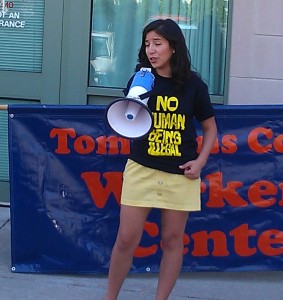On May 1st, International Workers Day, Over 60 People Attend Tompkins County Living Wage Working Group Hearings On County Contracts
Over 60 people attended Wednesday’s Public Hearing on Living Wages, with the overwhelming vast majority saying that Living Wages should be paid to all workers that are employed by Contractors with the County. A good portion of the speakers characterize paying a Living Wage as the morally right thing to do and a practice that benefits the entire community and addresses income inequality in today’s society. The conversation has reached enough of a fever pitch, thanks to Solid Waste workers, Stanley McPherson and Milton Webb (who work with ReCommunity Recycling) who believe they should be making a Living wage.


While expressing support in concept for payment of the livable wage, several representatives of non-profit organizations cautioned, however, that they face financial constraints, imposed by factors such as outside reimbursement levels, which make it difficult or impossible for them to pay a livable wage to all employees, without having to cut staff or receiving extra support from the County to fill the gap.
The current policy of the County calls for the County “to consider wage levels and benefits, particularly health care, provided by contractors when awarding bids or negotiating contracts, and to encourage the payment of livable wages whenever practical and reasonable.†A recent review of the policy found that most, but not all, individuals who are employed by contractors providing services to the County are paid a livable wage—currently $11.67/hour for employees who receive employer-provided health care benefits, and $12.68 for employees who don’t. In response to that review, the work group was formed to review whether the policy’s goals are being achieved and if either the policy or how it is executed should be modified.
Below is a statement made to the Working Group from one of the Tompkins County Workers’ Center’s founders, Carl Feuer:
Carl Feuer Statement on Tompkins County Livable Wage Policy
1. I urge the County to adopt a Living Wage Policy that ensures that all those working directly or indirectly for the County be paid a living wage. I believe the County needs to do this as a matter both of fundamental moral principle as well as to provide sorely needed leadership in a community where too many work too hard for too little pay that is not enough to sustain themselves or their families.
2. Second, this is not merely a local concern. One of the greatest issues facing our country and our world today is income inequality. In the United States this is a problem that has grown persistently and perniciously over the last 40 years. It has grown to such a level that economic demand is limited and growth is impeded. It has grown to such a level that our political system has become even more skewed toward those with wealth and income reinforcing the very tendencies that lead to the growth of inequality and economic instability in the first place. Pursuing policies that raise incomes at the lower end, such as I am urging you to consider now, not only helps local workers but also takes the moral high ground and sets a standard of action that hopefully will be emulated in the wider community and world. Think globally, act locally.
3. As you know over you are not alone in your efforts. Over 100 municipalities have already promulgated living wage laws of various stripes and comprehensiveness, including some here in NY State. You don’t have to reinvent the wheel.
4. While you will rightly be concerned with balancing the costs as well as the benefits of a living wage law, I am here to tell you that there is one cost that you must absolutely not ignore, limit or scrimp on. That is the cost associated with implementation. It is essential that you pay attention to implementation, including administration, public education and enforcement or else all your efforts may come to naught. That has been the sad experience in some communities.
5. I will also share an idea that would mitigate the cost to the county of implementation. In the 1980s the City of Ithaca under Mayor John Gutenberger promulgated a unique local plant closing notification statute with the intent being in part to identify and prevent local plant closures. In this case, the City deputized and funded the local Labor Coalition to implement this law. You might consider something similar in your deliberations, potentially working with the TC Workers Center to implement a County living wage law. Besides saving administrative costs, such an arrangement would take advantage of the Workers Center’s zeal and experience toward the goal of making any living wage law a success and a model for other communities.
6. And while we are on the subject of cost savings, here are some additional factors that are likely to ensue from a living wage law that will offset any costs to County taxpayers: the reduced demand for social services among county residents who will be paid a living wage when previously they received poverty level wages; increased business activity in the county as these same higher wages course through the local economy; positive effects on housing values and the county’s tax base as beneficiaries of the policy are better able to maintain their properties; the potential effect that the county’s action will have on other local employers whose own living wage pulse may quicken over time as the living wage becomes more accepted as a moral and community standard.
7. Further on the subject of cost, beware of overestimating the cost of a living wage law. One study of living wage laws concluded that costs typically were actually quite small and less than local officials initially expected, as contractors absorbed some or most of the costs. By “quite small†we are talking about an increase of less than 0.1% of the overall budget. The City of Ithaca, by the way, has just approved a budget that includes an increase roughly of that order (0.1%) to ensure that it meet the Tompkins County living wage standard. The County should surely be able to commit to a similar increase to ensure that all its contracted workers are paid a living wage.
8. Another way to mitigate cost is to consider some phasing in of the living wage mandate.
9. Human service providers with employees paid less than a living wage that contract with the County may need special consideration since their non-profit status limits their ability to absorb the cost. One mechanism to consider here would be for the County to actually subsidize some or all of the cost to these agencies of the mandated living wage requirement. In the latter part of the 1990s the County Legislature adopted this exact approach when it appropriated additional funds for various human service agencies to implement the Legislature’s commitment of ensuring that all workers on county-funded programs be paid a living wage.
